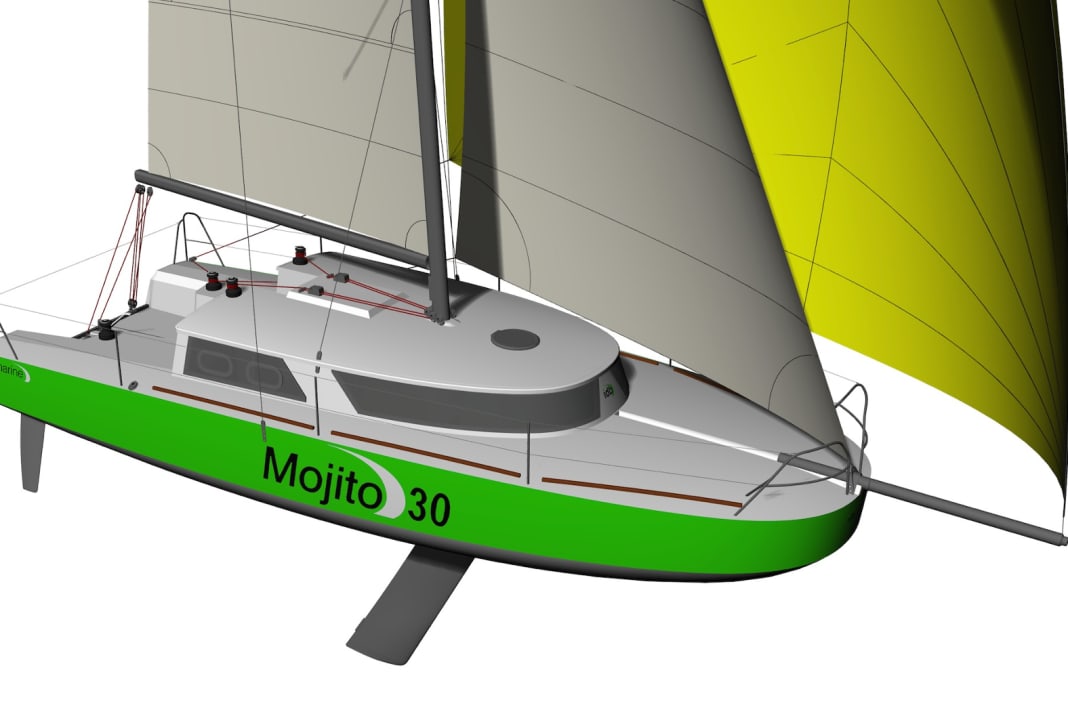





The project has apparently been on the mind of the new owner of IDB Marine, Denis Bourbigot, for some time. The new model for the Mojito range has now been officially unveiled at the recent inauguration of IDB's new production facility in Concarneau (Brittany). Apparently, build number 1 is already under construction and is scheduled for completion in spring 2024. This is indeed a very exciting prospect.
The most striking design feature of the new boat is also the round scow bow, as on the Mojito 650, which uses the hull of the successful Maxi 6.50, a boat in the Mini 6.50 offshore racing class. The construction plans for the Mojito 30 were also supplied by Mini Pope David Raison, supported this time by naval architect Pierre Delion. The main advantage of boats with scow bows is better and more balanced sailing characteristics on space wind courses. The design of the Mojito 30 also includes an electro-hydraulically retractable swivelling keel and two rudder blades. With additional wading props, the boat can also be dropped dry without any problems. Aluminium legs are pushed out on both sides through laminated tubes and locked in place. IDB Marine also offers this extremely innovative system exclusively for its Malango range of cruising boats.
Mojito 30: plenty of sail area, high performance potential
The shipyard wants to position the Mojito 30 on the market as a performance cruiser with high performance capabilities. The boat has also been specifically designed to meet the demands of regatta sailors, especially for use on longer offshore routes in single or double-handed mode - the keyword being transquadra. The high-performance sail plan with square-head top and overlapping genoa as well as the relatively low total weight of just under three tonnes also stand for this. The sail carrying capacity is quite high at 5.6, which usually characterises powerful regatta yachts. A gennaker or a code zero is used on a widely extendable bowsprit. A trough is moulded into the foredeck for the trunk. This allows the shipyard to dispense with a hull passage so that no water can enter the ship.
Despite all its sportiness, the Mojito 30 will also be fully equipped for touring below deck, with two double cabins, a spacious wet room, galley and navigation. There is also plenty of space aft on the port side for a large locker, which can also be accessed from the inside via a hatch. A layout of the interior is shown in the gallery above.
The shipyard also pays attention to sustainable construction and minimising the ecological footprint. The hull and deck are laminated in a sandwich with flax fibres and a foam core made from recycled PET bottles. However, IDB Marine has not yet announced a price. According to the management, it is still far too early for that.
Technical data Mojito 30
- CE design category: A/B
- Designer: David Raison/Pierre Delion
- Hull length: 9.30 m
- Width: 3.45 m
- Draught swing keel: 1.00-2.30 m
- Weight: 2.95 tonnes
- Ballast/proportion: 900 kg/30 %
- Mainsail: 35.0 m²
- Genoa: 28.0 m²
- Jib: 19.0 m²
- Gennaker: 85 m²
- Motorisation: Built-in diesel 21 hp or electric motor +
